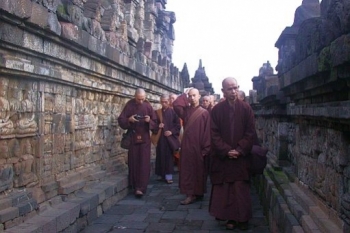In some of my past articles, I outlined some ways in which those of us who have a phobia of death may begin to contemplate impermanence and change. I described how I found it beneficial to approach the concept of change in a positive way initially before entering into a deeper contemplation on the finitude of things. However, these divisions of “positive”, “neutral” and “negative” contemplations are really only conventional categories to enable us to navigate our fears. In actual fact, all of these contemplations are equally powerful. Contemplating the beautiful aspect of change, the growing-up of our children, for instance, is in no way inferior to sitting in front of a decomposing corpse for days on end. Both practices are valid as they have in common the object of transiency or change.
A meditation on death is simply a part of the wider contemplation on transiency. Once it is seen in this way, our approach to the subject can become far more effective. This is because it is possible to view death as a process rather than
an event. If we dive straight in to contemplating dying, it is possible we will create an object of this process, an “event” in which we disappear. This terrible “event” that lies in wait for us at some point in the future, then becomes an object of fear and something we avoid thinking about in daily life. For me, the key to overcoming a fear of death is to begin to view death as a process, part of the wider change of life, to see death constantly in all things and not as a spectre that looms over us when we are old and sick.
The brilliant Thai monk, Buddhadasa Bhikkhu, saw the value of contemplating death in this way. He set aside the traditional interpretations on rebirth, which emphasise obtaining a new existence at the end of our lifespan, and focused on “rebirth” as a process, a perpetual death and birth in every single moment. According to Buddhadasa’s interpretation, with every sense contact, whether it be watching a movie or sipping coffee, our consciousness is changed by this stimulus and we are “reborn”, never to return to our old state again. In this way, any experience we have can be considered a death and rebirth, it is just we are not normally conscious of it.
Walking meditation provides a very useful tool to contemplate death in this way. When we are doing walking meditation along a track, it is sometimes useful to pause at the end of our path and to simply recognise the contents of our mind. This is not simply recognition of the mind’s contents but also recognition of how we feel to exist at that point. When we walk to the other end of our meditation path, we can pause again and do exactly the same contemplation. Then we can compare the content of the mind at one end of the walking path to the content at the other. We will be able to see clearly how we have changed, how we have undergone a “death” of sorts and how this happens in every moment.
During this practice it is sometimes useful, before we begin to walk down the meditation path, to simply recognise that our mind is already anticipating, albeit very subtly, the journey to the other end of the path. Our mind habitually expects that we are about to walk. If we are able to catch this intention and to hold it in our minds for contemplation, we can study how our mind anticipates and expects the existence of the future. When we walk mindfully to the other side of the path, we can then recollect our intention to walk and compare it with the reality of the walk. If we look deeply, we might be able to see the disparate nature between how we expected ourselves to walk and the reality of the walk. In this way, expectation and anticipation can be seen as illusory. In time, it might be possible to view all expectation as a habitual process of the mind, as simple as the intention to walk. Our fear of death, too, can ultimately be viewed in such a light; just as an anticipation of what is to come, only now “what is to come” becomes synonymous with “death”, a process that is no scarier than walking to the other side of a room.
















